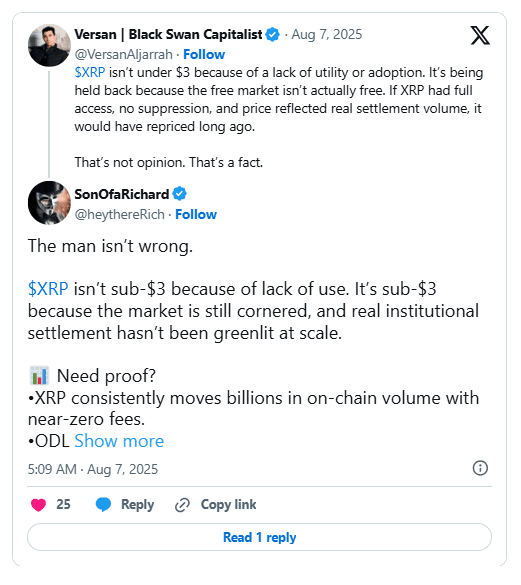A recent tweet from Versan Aljarrah, founder of Black Swan Capitalist, reignited the debate over the stagnant price of XRP, arguing that the asset's sub-$3 valuation is not due to weak fundamentals but rather market manipulation and regulatory bottlenecks.
"XRP won't go below $3 due to lack of utility or low acceptance," Aljarrah writes. "It is being suppressed because the free market isn't truly free."
According to Aljarrah, the true price of XRP is suppressed by limited market access and artificial constraints, not due to lack of acceptance or technological limitations. He asserts that if XRP were allowed to operate unrestricted, the market would have repriced to reflect actual utility and institutional demand.
"That's not an opinion. That's a fact," he added.

The Voice of the Industry Echo Support
Cryptocurrency influencer SonOfaRichard agreed with Versan’s viewpoint in a subsequent post, reinforcing the notion that the current price of XRP does not accurately reflect its utility or level of adoption.
"That man is not wrong," the post begins. "XRP going below $3 is not because few people are using it. It’s going below $3 because the market is still constrained."
He points out real-world use cases and existing infrastructure as evidence:
XRP moves billions in volume on-chain with negligible fees.
The ODL corridor (On-Demand Liquidity) settles faster than SWIFT, although access is limited.
The private ledger of XRP is currently being used for CBDC, tokenized treasury bonds, and real estate.
"Prices still do not accurately reflect reality," he said.

Waiting for "Traffic Regulations"
As regulatory transparency continues to improve in the U.S. and abroad, both analysts predict a significant market shift as institutional payment activities and tokenization expand on a large scale.
"Traffic regulations are coming," SonOfaRichard concluded. "And when they do, suppressed utility will not just increase—it will reprice dramatically."
With XRP at the center of ongoing discussions around real-time payments, asset tokenization, and regulatory reform, analysts suggest it may just be a matter of time before suppressed utility translates into visible price action.
